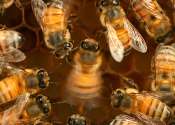Complex learned social behavior discovered in bee's 'waggle dance'
Passing down shared knowledge from one generation to the next is a hallmark of culture and allows animals to rapidly adapt to a changing environment.

Passing down shared knowledge from one generation to the next is a hallmark of culture and allows animals to rapidly adapt to a changing environment.
Plants & Animals
Mar 9, 2023
5
192

A fortnight after five lions escaped at Sydney's Taronga Zoo, an amused zoo visitor captured footage of Echo the superb lyrebird as he mimicked alarm sirens and evacuation calls with astonishing accuracy.
Plants & Animals
Nov 23, 2022
0
8

Electronic music lovers know the drill: as soon as the DJ turns up the bass, the crowd goes wild and dances with heightened enthusiasm. But to what extent is this a conscious reaction?
Other
Nov 8, 2022
0
857

Music, dance, drama and poetry are important elements of ritual in African societies. Imbalu, the centuries-old circumcision ritual of Uganda's Bagisu people, is no different. When Bagisu boys between the ages of 16 and 22 ...
Social Sciences
Oct 7, 2022
1
29

Music, dance, art and storytelling have allowed an international team of researchers to reveal aspects of air pollution in Nairobi that would not have been identified otherwise.
Environment
Dec 3, 2021
1
91

Scientists have carefully studied the intricacies of how individual organisms live and act together in groups known as biological collectives. In "superorganisms" such as bee colonies, the interactions of the individual members ...
Plants & Animals
Nov 10, 2021
0
336

By decoding honeybees' waggle dances, which tell other bees where to find food, researchers have found that bees in agricultural areas travel further for food than those in urban areas. The findings are published in the British ...
Ecology
Oct 6, 2021
0
419

"Ornaments composed of elk teeth suspended from or sown on to clothing emit a loud rattling noise when moving," says auditory archaeologist and Academy of Finland Research Fellow Riitta Rainio from the University of Helsinki. ...
Archaeology
Jun 3, 2021
0
818

Honeybees have a complex communication system. Between buzzes and body movements, they can direct hive mates to food sources, signal danger, and prepare for swarming—all indicators of colony health. And now, researchers ...
Plants & Animals
May 4, 2021
0
251

It is early in the morning. Ebi and his colleagues try not to twitch as they stare intently at a rectangular box filled with sugary treats. These aren't for them, but for the honey bees that they study. The tiny buzzers toggle ...
Plants & Animals
Jan 19, 2021
0
10